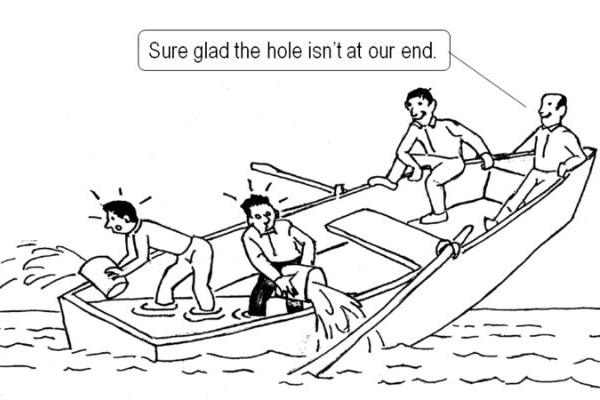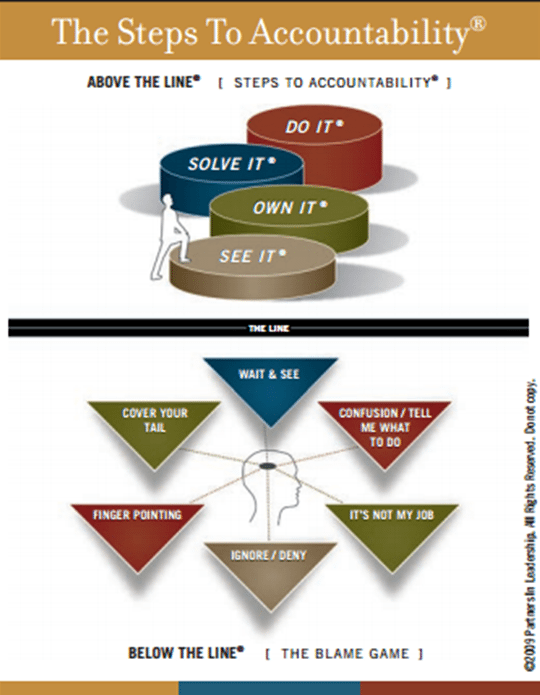We recently conducted a workshop for one of our existing clients. The brief given to us was that whenever team members encountered a problem or an obstacle, instead of looking at ways to overcome them or deal with problems, they often indulged in a blame game, finger pointing, attitude of helplessness, and consciously or unconsciously avoided accountability for individual or collective results. It instantly reminded us of this video, which shows the same behavior:
We spoke to a few participants before the workshop and realized that while most of the team members cared for the team’s performance, they were unconsciously stuck below the line (see image below). “Below the Line” is a concept from a book The Oz Principle, which is based on an enthralling story of The Wizard of Oz. Even the most ardent admirers of this story often fail to learn its simple lessons: Don’t get stuck on the yellow brick road. Don’t blame others for your circumstances; don’t wait for wizards to wave their magic wands; and don’t expect all your problems to disappear. In today’s complex environment, it’s easy to demonstrate all these behaviors and fall below the line.
We understood the core issue and designed a 2-day workshop based on The Oz Principle, which explains how these people can become a high performing team by moving Above the Line and climbing the Steps to Accountability. Let’s look at each of these Above the Line Behaviors or Steps to Accountability in detail.
Mustering the Courage to SEE IT:
Ex–Intel CEO Andy Grove asked his partner Gordon Moore, “If we were kicked out of the company, what do you think the new CEO would do?” They reasoned that a new leader would feel no emotional attachment to the declining memory chip business, and would probably leave it behind. Grove and Moore did likewise, as they shifted Intel’s focus to microprocessors. Grove and Moore’s decision to face some harsh realities and take their company to new direction showed the world that the willingness to SEE IT pays off and pays off handsomely, if you can muster the necessary courage, heart, and wisdom to accept it.
On the other hand, we know the fate of the companies like Nokia, Blackberry, Kodak, and IBM who refused to SEE IT and acknowledge the changes happening around them and had to face the consequences.
- Recognize when you fall Below the Line
- Acknowledge and accept REALITY
Finding the Heart to OWN IT:
There is an old adage, “if you are not part of the solution, you are part of the problem.” Well, ownership implies that, “if you are not part of the problem, you are not part of the solution.”
Indian cricket test captain Virat Kohli scores a century in a 1-day match and after he gets out the entire team collapses and team loses the match. It’s easy for Virat to put the blame on others and say he did his part by scoring a century and other batsmen did not support him. However, during a post match press conference when asked, “what has the team learnt from this,” Virat replied by saying that he takes the responsibility for the defeat as he should not have got out and should have taken the team to victory.
Accountable people accept whatever ways in which their own behavior contributes to the situation and set about overcoming those circumstances, no matter how difficult. Just because Virat Kohli has taken the responsibility does that mean he is never supposed to get out in that situation? Well, no we can’t expect that, but because he has admitted his mistakes, and he will practice harder in the nets to overcome that situation in the next match.
Owning our circumstances gives us strength to overcome the powerlessness that comes from being a victim and allows us to move forward and achieve more satisfying results in life.
- Don’t let yourself off the hook!
- Own the whole reality and admit mistakes!
Obtaining the wisdom to SOLVE IT:
The “Solve It” attitude and behavior stem from continually asking the question, “What else can I do?” By constantly and rigorously asking this question, you avoid slipping back into the victim cycle whenever events occur that would otherwise seem to block the road to results
Take a look at an example of SR Rao, who did his job differently from other municipal commissioners before him and transformed Surat to make it India’s second cleanest city, in 20 years flat. With no additional resources and no directive handed to him, he went about his job and shifted the orbit of the entire city. When he took the charge as Surat’s commissioner in 1995, he inherited the city that has been afflicted with a disease of plague.
When Rao asked his colleagues about the reason for city’s filthy situation, they complained, “People are bad, citizens are bad, and they throw garbage on the streets, it’s part of the genetic make up of the population here.” But Rao challenged the status quo with a SOLVE IT attitude and brought down 22,000 malarial deaths in the city to 0 in 5 years.
- What else can I do? Take initiatives
- Fully commit yourself to stay Above the Line during problem solving!
- Think differently
- Persist
Exercising the means to DO IT:
Ultimately accountability means accepting the full responsibility to achieve results and DO IT. If you don’t DO IT, you’ll never reap the most valuable benefit of full accountability: overcoming your circumstances and achieving the results you want.
In his parting speech, Nokia’s ex-CEO ended it by saying, “we didn’t do anything wrong, but somehow we lost.” I feel they lost because they didn’t do anything when the world was changing around them.
- Embrace your full responsibility for results
- Empower your team to take risks
We hope you have identified where you and your team members stand currently – Above the Line or Below The Line. You can begin to promote The Oz Principle by encouraging your team to climb out of the victim cycle and ascend the Steps To Accountability. Let us know if this type of team session would benefit you and your team today. Do share your feedback with us in the comments below.


